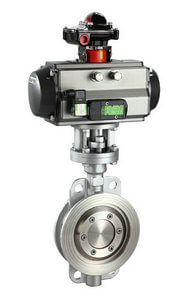Features of Stainless Steel Valves
Generally speaking, stainless steel valves are valves made of stainless steel. They are classified according to the stainless steel material grade of the valve body. They are mainly 301, 304, 316, 304L, 316L, etc. According to international standards, they can be divided into CF8, CF3, CF8M, CF3M, the quality of the material

D673H-16C-stainless steel pneumatic triple eccentric butterfly valve
CF8<CF3<CF8M<CF3M. Because stainless steel has strong corrosion resistance, is easy to form, has high compatibility, and can remain strong in a wide temperature range, many advantages make stainless steel valves widely used in heavy industry, light industry, daily necessities industry and architectural decoration industry. middle.
Stainless steel refers to steel that is resistant to corrosion by weak corrosive media such as air, steam, water and chemical corrosive media such as acids, alkalis, and salts. It is also called stainless acid-resistant steel. Stainless steel valves are also stainless acid-resistant steel valves. , And resistant to acid and alkali corrosion. Research tests have shown that the corrosion resistance of steel in weak media such as the atmosphere and water and oxidizing media such as nitric acid will increase with the increase of the chromium water content in the steel. When the chromium content reaches a certain percentage, the corrosion resistance of steel The sex changes, that is, from easy to rust to not easy to rust, from no corrosion resistance to corrosion resistance.
Common stainless steel valves mainly include stainless steel butterfly valves and stainless steel ball valves. The gate valve is rarely made of stainless steel, because the gate valve is usually used for low corrosive media such as water.
Stainless steel butterfly valve, also known as stainless steel flap valve, usually adopts three-eccentric metal hard sealing structure. The valve body, valve seat and butterfly plate sealing surface are all made of stainless steel with different hardness, which has strong corrosion resistance and long service life. It is widely used in metallurgical, electric power, petrochemical, water supply and drainage, municipal construction and other industrial pipelines with fluid pipeline medium temperature ≤ 425°C.
Stainless steel ball valves usually require horizontal installation in the pipeline. Stainless steel ball valves can be divided into stainless steel pneumatic ball valves, stainless steel electric ball valves, and stainless steel manual ball valves according to the driving mode. According to different stainless steel materials, it is divided into 304, 316, 321 stainless steel ball valves. The stainless steel ball valve switch is light and can also be made into a large diameter. It has reliable sealing, simple structure and convenient maintenance. The sealing surface and spherical surface are often in a closed state and are not easily eroded by the medium. It has applications in various industries.
TH Valve is a professional manufacturer of butterfly valve, gate valve, check valve, globe valve, knife gate valve, ball valve with API, JIS, DIN standard, used in Oil, Gas, Marine industry, Water supply and drainage, fire fighting, shipbuilding, water treatment and other systems, with Nominal Diameter of DN50 to DN1200, NBR/EPDM/VITON, Certificates & Approvals: DNV-GL, Lloyds, DNV, BV, API, ABS, CCS. Standards: EN 593, API609, API6D
Related news/knowledge:
Prevention and treatment of valve corrosion
The main classification and use conditions of valve sealing materials
How to achieve internal and external anti-corrosion of pneumatic valves
The difference and application of stainless steel 430, 304, 316



 © Copyright 2020 Tianjin Tanghaidongyang Valve Co., Ltd. All Rights Reserved.
© Copyright 2020 Tianjin Tanghaidongyang Valve Co., Ltd. All Rights Reserved.